HAROLD AND MAUDE: Revisiting Hal Ashby’s Inspirational Cult Classic After 50 Years
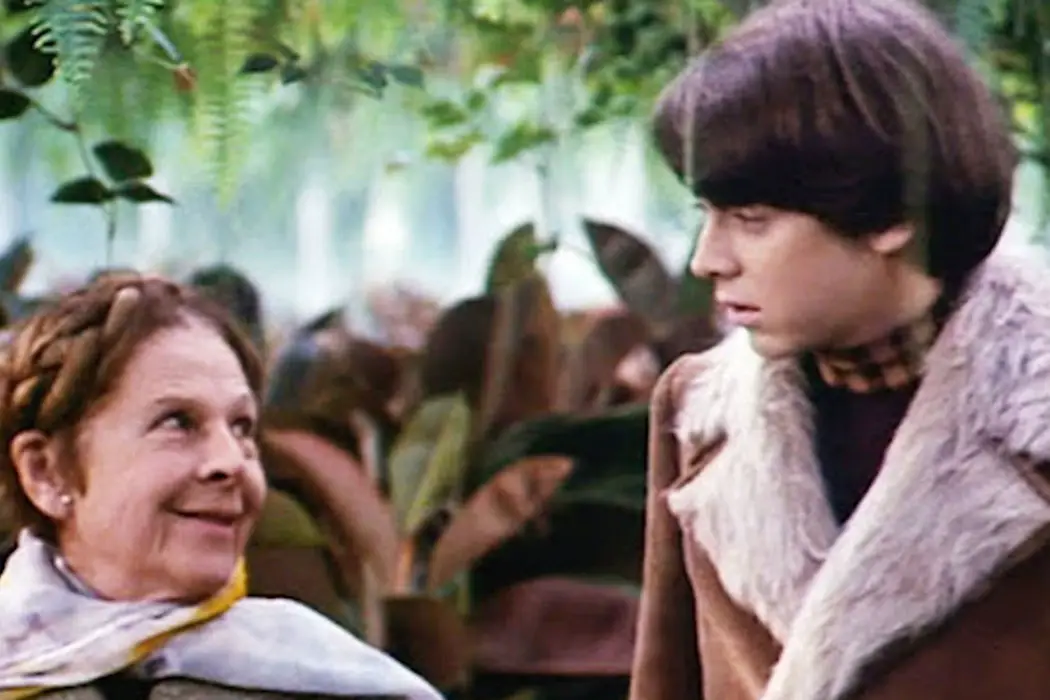
David is a film aficionado from Colchester, Connecticut. He enjoys…
It may be hard to believe, but Harold and Maude is now a half-century old. It first premiered on December 20, 1971, and though at the time was not very well received, it has since grown into a bona fide cult classic, with many prominent critics citing it amongst their favorite films. After seeing it for the first time several years ago, I fell in love with it as well, finding that it spoke to me in unique and interesting ways. Many viewings later (with one being a rather awkward viewing with some people who absolutely did not care for it), I still find myself fond of Hal Ashby‘s film. In this article, I will lay out the reasons for the film’s eventual success, and why it deserved to become the classic that many of us now know and love today.
The Story and Direction
Harold and Maude primarily focuses on its two titular characters. They are Harold (Bud Cort), a young boy of about 20 years old who lives in a wealthy household with his uptight mother (Vivian Pickles). Harold is reclusive and distant, often resorting to elaborate schemes to get attention; in particular, a series of fake suicides that he makes throughout the film. Indeed, the film itself begins with one of these “suicides,” with a light and hearty song by Cat Stevens leading up to Harold hanging himself in his living room, his body swaying back and forth. His mother soon enters the room, sees Harold handing there, and yet oddly seems unaffected by it.
In case you didn’t realize from this scene alone, Harold is an unusual boy, who also attends funerals in his spare time. It’s at one of these that he meets Maude (Ruth Gordon), an older lady who is vivacious and chatty. Harold is at first taken aback by her sheer contrast with everyone else in his life, but soon finds himself drawn to her, and the two form a friendship, which eventually leads to more (but more on that later).
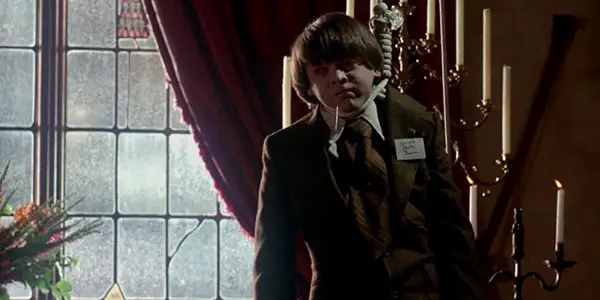
The film takes place in a single week, focusing on the budding relationship of Harold and Maude. While they first meet at a funeral, they soon embark on other adventures, such as going for walks in the surrounding hills, replanting a dying tree from the town-center into the woods, going to an amusement park, and more. Amongst it all, Maude’s clear love for life is an infectious draw for Harold, who is continually amazed by her words and occasionally chaotic actions. This leads to some of the film’s more humorous moments, such as Maude’s ability to steal seemingly any car and her erratic driving. In reality, it’s hard to believe that she has gotten through life at this point without being arrested. But that’s part of her unavoidable charm.
The story of Harold and Maude itself may be unique; so, for that matter, is the way it came about. The script was written by Colin Higgins, who at the time was a student at UCLA. Having presented it to someone working in the film industry, they were impressed with the script and were even going to bring Higgins to direct; however, after unsuccessful test runs, Hal Ashby was brought on board. Ashby, who at the time was more known as an editor, had directed one film called The Landlord. He would go on from Harold and Maude to have a successful Hollywood career, which includes The Last Detail, Shampoo, Being There, and more. But it’s really Harold and Maude that started him on the path to success.
The Characters
When Harold and Maude first meet, they are on opposite ends of the spectrum. Harold is withdrawn and clearly unhappy, while Maude is a spark of life. But in just the course of a week, Harold is smiling and laughing, learning to play the banjo, and defying his mother by denying her the ability to choose his life for him; for example, creating an elaborate scheme in order to stop her from sending him to the army alongside his self-serious uncle General Victor Ball (Charles Tyner). In contrast, Maude is already developed by the time we meet her. We don’t quite know how she got to be the vivacious person she is today, with the only hint towards her past being a tattoo from a concentration camp on her arm that we see briefly at one point. It could be determined that Maude is a bit mad, in a way, such as in her disregard for typical societal norms; but is she so outside the realms of reality that we shouldn’t all aspire to be like her?
The characters are brought to life by Bud Cort and Ruth Gordon, respectively. The young Cort shows sophistication in his performance, especially for one that forces him to be so withdrawn for much of it. With subtle changes in behavior and facial expression, he manages to convey a believable arc for Harold, becoming someone almost unrecognizable by the conclusion of the film. Ruth Gordon, who many might know as the evil old woman from Rosemary’s Baby, here gives quite an opposite performance, managing to be endlessly likable and charming. There is now even a “religion” of sorts called Maudism, which emphasizes the importance of living life to the fullest, and it is Gordon‘s idyllic performance that lends itself to this.
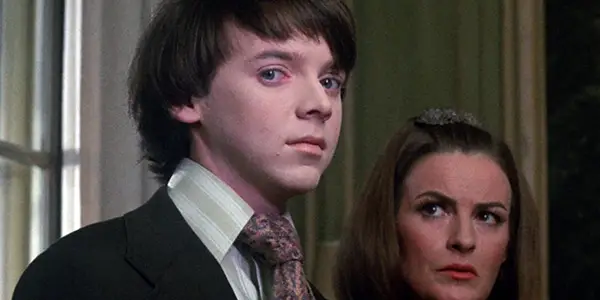
Amongst the supporting characters, a particular standout is Vivian Pickles as Harold’s mother. She is just as overbearing and ruthless as you would expect the mother of a well-to-do family to be. At one point, she fills out a questionaire for Harold that will be sent out to prospective women for her son to marry, and rather than ask Harold his own answers, she fills out the entire survey as if she was him. It’s clear that Harold doesn’t get much say in his own life, and this moment (and Pickle‘s obnoxious responses) personifies that.
Cinematography and Music
The characters of Harold and Maude are its lifeblood; but the visual and auditory elements of the film tell its story just as well. The cinematography by John A. Alonzo as well as the production design is stunning throughout, lending itself to the repeating theme of contrasts. For example, though Harold’s family is well-off and he lives in a giant house, the house itself is not seen in an impressive way. Instead, it’s often dark and colorless, with uninspired decorations and formulaic layouts. Interiors as a whole, such as General Ball’s office, are seen as pointed and dull, with a couple of images on their walls but nothing remarkable. The one exception to this is Maude’s “house,” which is itself an abandoned train. Inside it, there are a plethora of unexpected objects, colorful paintings, and even some provocative sculptures, as if by stepping through the door to her domicile we are entering her own uniquely-tuned mind.
But it’s the outside landscapes where Harold and Maude really comes to life. Seeing our characters expressed as dots on top of a hill, for example, or witnessing the birds at sunset on the water, they all express the poetic simplicity of life and all of its wonders; that is, once we choose to see it from this perspective. Once Harold starts to be affected by Maude, his world literally opens up as well. At one point, caught up in the manic beauty of it, he starts to do somersaults; even now, he has changed from the character we knew him as in the start of the film.
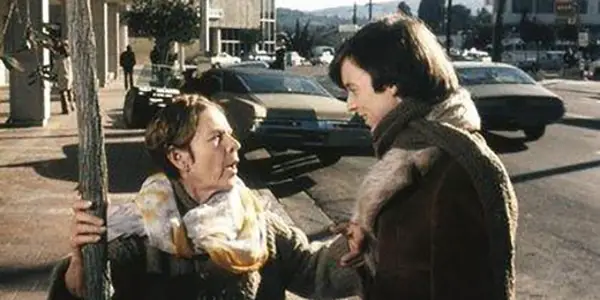
The music itself also provides the heartbeat of the film, and I couldn’t think of anyone more perfect than Cat Stevens to do this. His calm voice and guitar-strumming sets the tone of the film. The songs are played at opportune moments throughout, such as transitions between a scene and in the background as Harold and Maude get to know each other, with the lyrics saying a lot about their growing relationship. They also occasionally also lend themselves itself to more troublesome moments as well such as the use of the song “Trouble” towards the end.
One of Stevens‘ more well-known songs, “If You Want to Sing Out, Sing Out” was actually written for the film, and is at one time sung by Maude on the piano seemingly as a song that she made up, before being Stevens’ version is played over the film itself later on. Just the lyrics of this song alone express one of the main themes of the film: to be your own self, no matter who you choose to be, and to not let anyone else tell you otherwise.
Themes
It’s easy to see why people were not immediately taken in by Harold and Maude at its time of release; indeed, as mentioned, even people I have shown it to who didn’t know what to expect were taken aback by it. They’re turned off by the fake suicides of Harold, or some of the film’s darker implications. Even more than that, it’s the romantic aspects of the film that seem to throw people off way more than anything else. The romance between an older woman and a younger man is itself seen as somehow “disgusting” (as is expressed by a character within the film) despite the fact that if you reversed the genders, people would not be as turned off by it. But, all prejudices aside, I’m here to tell you that I don’t even think Harold and Maude is a romance at all. At least, it’s not a romance in the traditional sense. Harold and Maude is, at its core, the story of life and death; it’s about a boy obsessed with death who comes to fall in love with life instead.
Indeed, throughout the film, the budding relationship between Harold and Maude is not seen as particularly romantic. Harold starts to fall for her, but Maude only seems to respond positively in that he now loves at all, when he seemed so dead and empty before. They do have sex at one point, but it’s not seen as a big deal, and, indeed, their relationship doesn’t affect Maude’s ultimate choice in the end. Instead, you are supposed to see their relationship as a metaphor; most of us are Harold, treading through life, barely making our own choices, when we could be Maude, having a fulfilling life and making the most of every day. Ironically, if you love and indulge in life, death itself isn’t seen as a tragedy either.
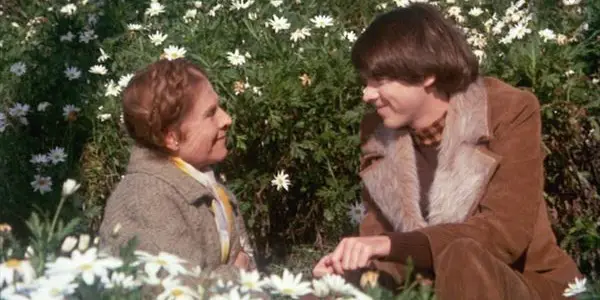
In one scene, for example, Harold and Maude are looking at a field of daisies. Maude asks Harold what kind of flower he would want to come back as, and he replies as a daisy, because “they are the same as everyone else.” But Maude points out the subtle differences, claiming that they’re not all the same, and that some of the problems in the world are that people fail to see themselves as more than ordinary, not seeing the beauty even in who they are. Immediately following this scene, the two are sitting amongst an endless row of gravestones. The image may seem morbid, but it’s anything but: there’s beauty in life, but there’s beauty in death as well, the great connector of us all – basically, a life well-lived leads to an eternity of peace.
As such, Maude’s death by the end is not seen as a tragedy; indeed, it’s what she wants more than anything as she refuses treatment for the pills she took. And though Harold seems to take it harshly, seemingly even attempting to end his own life by crashing his car over a cliff, instead he chooses to live, dancing away into the green hills beyond while playing the banjo that Maude had given him. He comes away a better person because of his time with Maude, even though it was short and ended abruptly. Because her zest and optimism for life made him realize that maybe it’s all worth it as well. There’s some uncertainty here about where Harold will go after this moment. But it’s the uncertainty that’s part of the thrill of it.
As Maude herself says at one point: “Reach out. Take a chance. Get hurt even. But play as well as you can. Go team, go! Give me an L. Give me an I. Give me a V. Give me an E. L-I-V-E. LIVE! Otherwise, you got nothing to talk about in the locker room.” Now that’s a sentiment I can get behind.
Personal Thoughts and Conclusion
Even more so than its celebratory aspects, Harold and Maude holds a special place in my heart because of what it meant to me when I first watched it. I was about 20-years-old, close to Harold’s age, and in many ways I saw myself reflected in him; from his distant nature, his shyness, and even, in a way, with a family that tried to push him in life to do what they felt was the right choice for him. Seeing Maude appear on screen was like a breath of fresh air, and it made me realize, even in the slightest way, that perhaps I could live a more fulfilling and enriching life, making my own choices in order to be truly happy. I’ll always be grateful for this perspective that Harold and Maude gave me, and I relive that first experience every time I rewatch the film. It’s for that reason it remains dear to me, and though it may not speak to others the same way, I’ll always treasure this wonderful film.
What are your thoughts on Harold and Maude? Do you think it deserves its status as a cult classic? Let us know in the comments below.
Does content like this matter to you?
Become a Member and support film journalism. Unlock access to all of Film Inquiry`s great articles. Join a community of like-minded readers who are passionate about cinema - get access to our private members Network, give back to independent filmmakers, and more.
David is a film aficionado from Colchester, Connecticut. He enjoys writing, reading, analyzing, and of course, watching movies. His favorite genres are westerns, crime dramas, horror, and sci-fis. He also enjoys binge-watching TV shows on Netflix.













